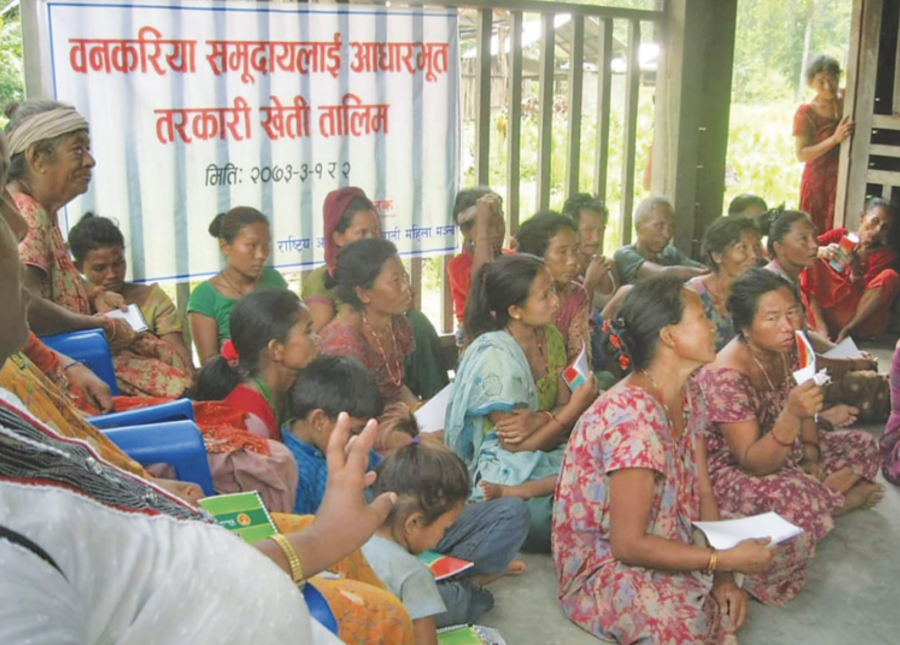National
Bankariya people have become squatters in their own land
The endangered community members, known as the ‘children of land’, are rendered landless, a violation of their fundamental right to life, security, shelter and dignity.
Aarati Ray
Sixty-year-old Santamaya Bankariya often questions how her people, known as ‘bhumiputra’ or children of the soil, have become landless (bhumihin) in their own land. This is in fact a concern of many Bankariya individuals, one of Nepal’s most endangered indigenous communities.
They have built houses but they can’t call them their ‘home’; they have land but no legal ownership. And hence, the ‘children of the land’ have become landless, squatting on their ancestral territory, a situation that has rendered them vulnerable and marginalised.
Santamaya was born and raised in the forest and lived a nomadic life until she was 40, when her family and other Bankariya people moved to human settlements. The Bankariya, now settled at Musedhar of Manahari Rural Municipality’s ward 4 in Makwanpur district, are on the verge of extinction, plagued by landlessness and a lack of modern skills and knowledge.
They are one of the 10 endangered tribes recognised by the Nepal government, alongside Kusunda, Raute, Surel, Hayu, Kisan, Lepcha, Meche, Raji and Kushwadiya.
The Bankariya are the latest ethnic tribal group to adopt a settled lifestyle, according to research by Gokarna Prasad Gyanwali, an anthropology professor at Patan Multiple Campus. In the course of abandoning nomadic life and acclimatising to modern societies, they face issues like food shortages, lack of agricultural land, health and sanitation problems, and illiteracy.
Economic participation remains elusive for the Bankariya tribe as they don’t have permanent, self-owned homes. Constant threats of relocation from the land under Parsa National Park’s jurisdiction hinder their ability to firmly establish themselves.
In 2005, the government signed a 20-year lease deal with the Bankariya, granting them six hectares of land as leasehold forest. However, with the deal set to expire next year and requiring annual renewal, uncertainty about their land tenure persists, says Suni Lama, chairperson of the National Indigenous Women Forum (NIWF).
Initially, settling into a new lifestyle was challenging for the Bankariya, who relied on frequent forest visits for food and herbs. “Slowly, we adapted to it,” Santamaya recalls. “But we still miss our connection with nature.” The forest as part of Parsa Wildlife Reserve (PWR), which was once their primary source of sustenance and cultural identity, is now off-limits to them.
Natural disasters like floods and earthquakes add to their woes, especially floods due to their riverside location. “With rising water levels in the rivers this season, we fear floods every night,” Santamaya says. “The government should pay attention to the damaged river dams.”
The community’s agricultural efforts too are limited by their lack of land ownership. As their 20-year lease nears its end, fear looms large. “The current ward chairperson assures us we won’t be evicted,” says Krishna Bahadur Bankariya, Santamaya’s 62-year-old husband. “But who knows what the future holds under a new chairperson?”
Santamaya adds, “We left the forest for security, yet we are still insecure. My husband and I have spent our lives worrying, and now my children do too. I don’t want the same fate for my grandchildren.”
According to Prakash Thapa, the ward chair, the Bankariya community currently consists of 20 houses with a total population of 93. “Nepal’s constitution guarantees access to land and property to everyone,” he says. “But the state has failed to provide it to the Bankariya community. It feels like a state failure to me.”
Santoshi Bankariya, 29, who is the community leader, says that they can’t start any business as they lack land registered in their names. “The government requires a ‘lalpurja’ (land registration certificate) for business registration, entrepreneurship, or any agricultural activities,” she notes.
The lack of land ownership severely limits their ability to sustain themselves. Last year, inspired by soap-making training provided by NIWF, Santoshi led the establishment of the Bankariya Chepang Women’s Soap Industry.
“We could register it only because the ward chairperson provided us with his lalpurja,” Santoshi explains. “While his support was immense, how long will we have to rely on others’ help even to be eligible for a job?”
That the community is settled on the buffer zone of PWR brings another set of challenges.
Santoshi recounts an incident in 2021 where seven Bankariyas were detained by army officials under the pretext of entering the core area of PWR without permission. “We have to fear going to the forest where our ancestors lived and which we’ve protected for ages,” Santoshi says. “Current restrictions make us feel like criminals in our own home.”
According to Thapa, there’s a difference between a national park, designated as a protected area, and a buffer zone intended for human settlement.
Unfortunately, PWR officials often misinterpret this distinction, leading to restrictions that go against legal regulations and create difficulties for the Bankariya community.
While Thapa understands the importance of protecting national parks, he also urges the Department of National Parks to ensure that buffer zone communities have access to essential resources. “Responsible local use can help with forest conservation, an issue the government needs to address,” he said.
In an interview with the Post, Yasso Kanti Bhattachan, regional council member of the Asia Pacific Forum on Women, Law and Development (APFWLD) and vice chair of NIWF, also raised concerns about discrepancies in Bankariya population data, noting that while the current count is 93, the 2021 national census reported the population to be 180, leading to confusion.
There are concerns that some Chepang individuals may have identified as Bankariya due to cultural similarities, possibly to access social security benefits specific to the Bankariya community. “This issue requires careful study and research,” Bhattachan says.
Nepal, as a signatory to International Labour Organization Convention No. 169, is obligated to recognise indigenous peoples’ rights to their traditional lands and resources, respecting their cultural values as enshrined in national law.
The Article 14.1 of the convention highlights these rights, while Article 14.2 mandates governments to identify and protect these lands, ensuring proper demarcation or registration in the indigenous peoples’ names where applicable.
These international obligations highlight the state’s duty to safeguard the land rights of communities like the Bankariya.
Bhattachan shares that their organisation has formally submitted a memorandum for land certificates addressing ministries three times—to the then Minister of Land Reform and Management Gopal Dahit in 2017; to then Minister for Land Management, Cooperatives, and Poverty Alleviation Shashi Shrestha in 2022; and to then Minister for Agriculture and Livestock DevelopmentRajendra Man Shrestha in 2023.
Former minister Rajendra Man says that he had forwarded the memorandum presented by the NIWF and recommended the issue to the chief minister of Bagmati and also to the federal minister, Ranjita Shrestha, in 2023. “After that, I couldn’t follow up, so I am unaware of subsequent developments,” he says. “But I had indeed made an effort to make sure that the case reached their table.”
Lama says that as they got no results, they had sought a meeting with former Prime Minister Puspa Kamal Dahal, but the opportunity did not materialise.
“The government has changed again and with that, we have to begin the process anew,” Lama says.
Bhattachan says that there has been some government discussion on relocating the Bankariya community and providing them alternative arrangements but the community “wants to remain in their ancestral lands”.
The government discussions on providing alternative arrangements goes against Convention No. 169. Regarding displacement, Article 16.1 specifies that indigenous peoples should not be forcibly removed from their territories unless under exceptional circumstances and with free, prior, and informed consent, as outlined in national legislation.
Without security in access to land, the Bankariya community faces compromised basic rights to food, shelter, and health, along with risks to their culture, traditions, and language. Gyanwali’s research, too, points out that “globalisation, Christianisation, and Hinduisation have led to the near-extinction of Bankariya cultural patterns and traditional knowledge systems.”
Without Indigenous people who are custodians of nature and forest, conservation will never be complete and successful, Bhattachan says.
Although indigenous people make up less than 5 percent of the global population, they protect 80 percent of the earth’s remaining biodiversity. This critical contribution is highlighted in the World Economic Forum’s 2023 report on Embedding Indigenous Knowledge in the Conservation and Restoration of Landscapes.
Santamaya says that she hopes the government listens to their appeal before she dies. “I want to breathe my last on my own land,” she says. “I fear that even in death, I won’t find peace, knowing that my children and grandchildren might face eviction at any time and have nowhere to go.”




 5.05°C Kathmandu
5.05°C Kathmandu







%20(1).jpg&w=300&height=200)






